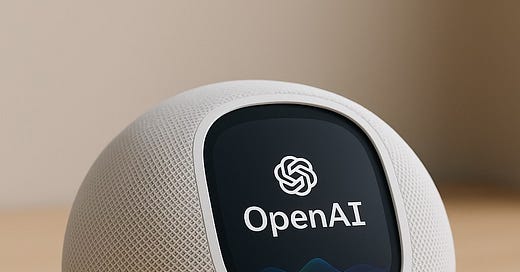The Next Interface: Why OpenAI’s Move Into Hardware Is Bigger Than You Think
The news that OpenAI is acquiring Jony Ive’s design firm didn’t just break the internet. It may have cracked open the next chapter of human-computer interaction.
On the surface, it sounds like a splashy headline: the world’s most influential AI company teaming up with the designer who helped shape the iPhone, iMac, and Apple Watch. But this move isn’t about aesthetics. It’s about control.
Control over the interface.
For the past decade, AI has mostly lived behind the scenes: cloud-based, ambient, and abstract. The breakthroughs in generative models and autonomous agents have been stunning. But the way we interact with these systems? Still stuck in outdated paradigms. Screens, keyboards, clunky voice assistants.
That’s the bottleneck. And OpenAI knows it.
By bringing Jony Ive into the fold, OpenAI is signaling a broader ambition: to rethink how we experience intelligence. Not just through apps or prompts, but through frictionless design that makes AI feel intuitive, trusted…even invisible.
From Capability to Experience
At GK Digital Ventures, we advise and invest in companies at the intersection of emerging tech and human behavior. And the pattern is clear: the next wave of transformation won’t be about what AI can do. It will be about how we experience it.
You can build the most powerful model in the world, but if it’s hard to use, misunderstood, or lacks trust, it fails. Design is the bridge between capability and adoption. It’s how we embed intelligence into real lives.
This isn’t new. It’s what made the iPhone revolutionary: not the tech inside, but the experience it delivered. The same will be true for the next generation of AI-native products.
The Hardware Arms Race Is On
OpenAI isn’t alone. Humane, Rabbit, Meta, Apple, and others are racing to define the next great interface. Not a smartphone replacement, something entirely new.
Maybe it’s ambient. Maybe it’s wearable. Maybe it’s embedded in your home or your car. Whatever form it takes, the underlying insight is the same: the companies that control the interface will shape the future of AI.
Because whoever owns the user experience owns the customer relationship. And in the age of intelligent systems, that’s everything.
What Comes Next
At GK Digital Ventures, we’re already working with companies rethinking what AI-powered interaction looks like…across consumer tech, health, mobility, media, and more.
We’re seeing new prototypes that strip away unnecessary inputs. Voice and gesture interfaces that anticipate needs. Devices that don’t look like devices. Interfaces that emphasize context and subtlety over command and control.
The future of AI isn’t louder. It’s quieter. Smarter. More seamlessly integrated into our lives.
We’re advising founders and Fortune 500 leaders who understand that this next phase isn’t just about building AI. It’s about designing for trust, usability, and impact.
Because the next leap in AI won’t come from a lab.
It’ll come from your living room.
Greg Kahn is the CEO of GK Digital Ventures, advising and investing in the next wave of companies at the intersection of AI, media, and technology. He writes regularly on human-centered innovation, strategic transformation, and emerging interfaces.
Subscribe for more insights on where the future is heading — and who’s building it.




